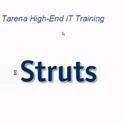For decades, aspects of the topological architecture, and of the mechanical as well as other physical behaviors of periodic lattice truss materials (PLTMs) have been massively studied. Their approximate infinite design space presents a double-edged sword, implying on one hand dramatic designability in fulfilling the requirement of various performance, but on the other hand unexpected intractability in determining the best candidate with tailoring properties. In recent years, the development of additive manufacturing and artificial intelligence spurs an explosion in the methods exploring the design space and searching its boundaries. However, regrettably, a normative description with sufficient information of PLTMs applying to machine learning has not yet been constructed, which confines the inverse design to some discrete and small scrutinized space. In the current paper, we develop a system of canonical descriptors for PLTMs, encoding not only the geometrical configurations but also mechanical properties into matrix forms to establish good quantitative correlations between structures and mechanical behaviors. The system mainly consists of the geometry matrix for the lattice node configuration, density, stretching and bending stiffness matrices for the lattice strut properties, as well as packing matrix for the principal periodic orientation. All these matrices are theoretically derived based on the intrinsic nature of PLTMs, leading to concise descriptions and sufficient information. The characteristics, including the completeness and uniqueness, of the descriptors are analyzed. In addition, we discuss how the current system of descriptors can be applied to the database construction and material discovery, and indicate the possible open problems.
翻译:暂无翻译




